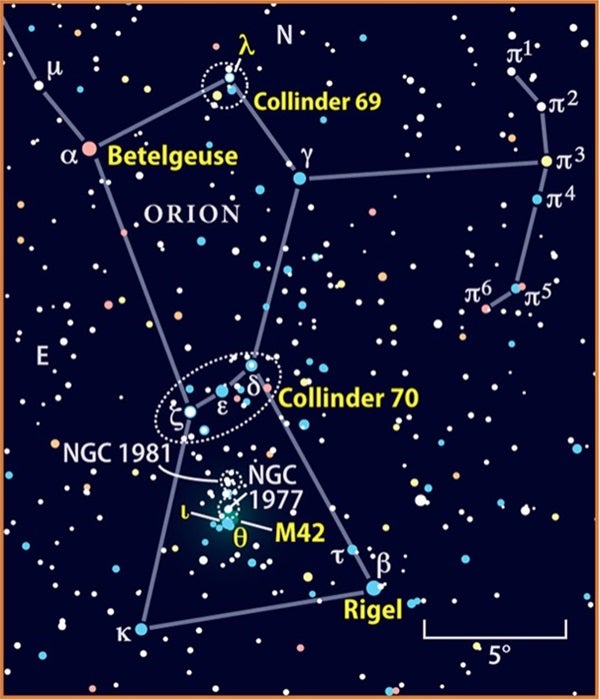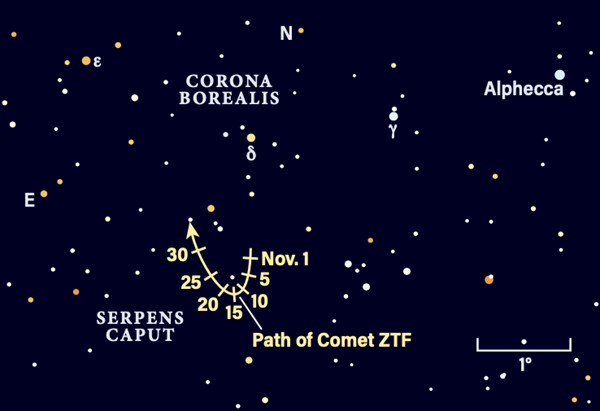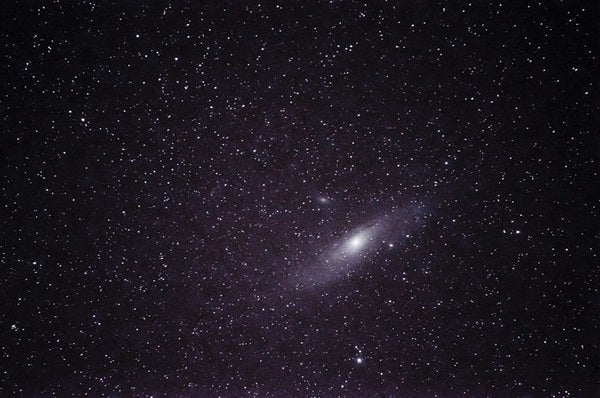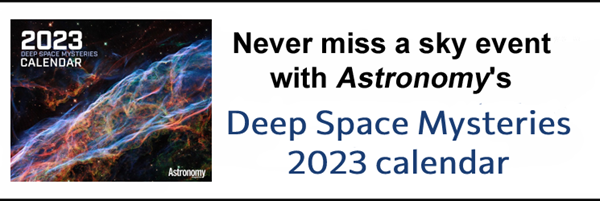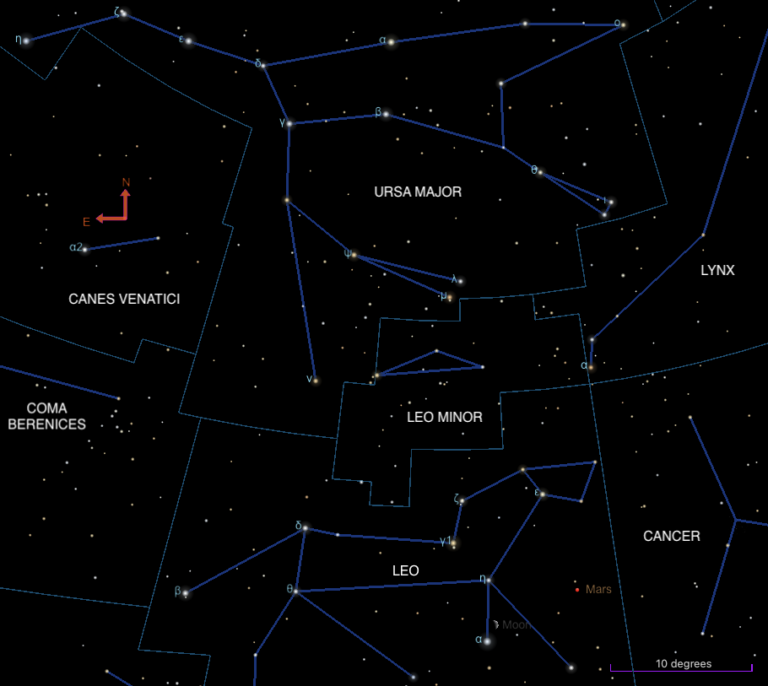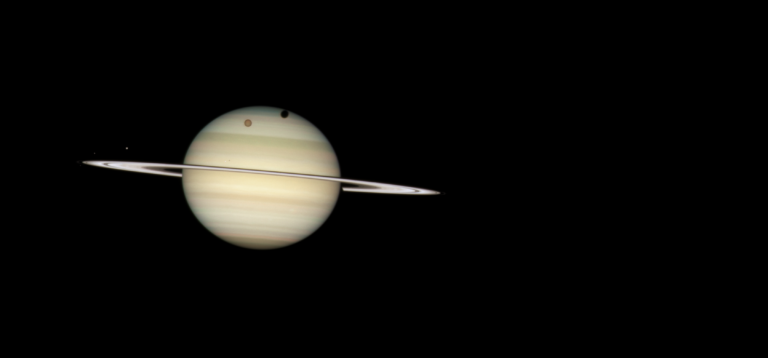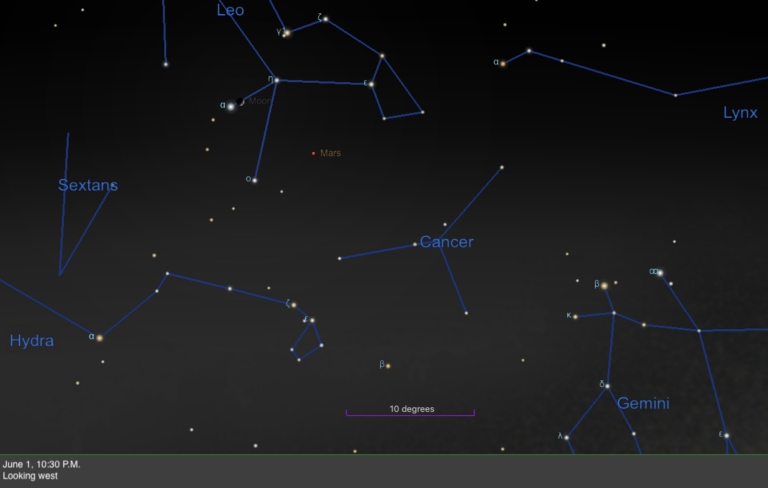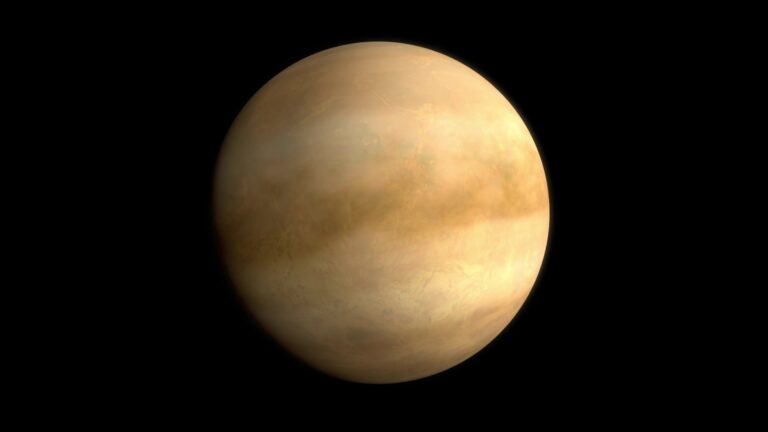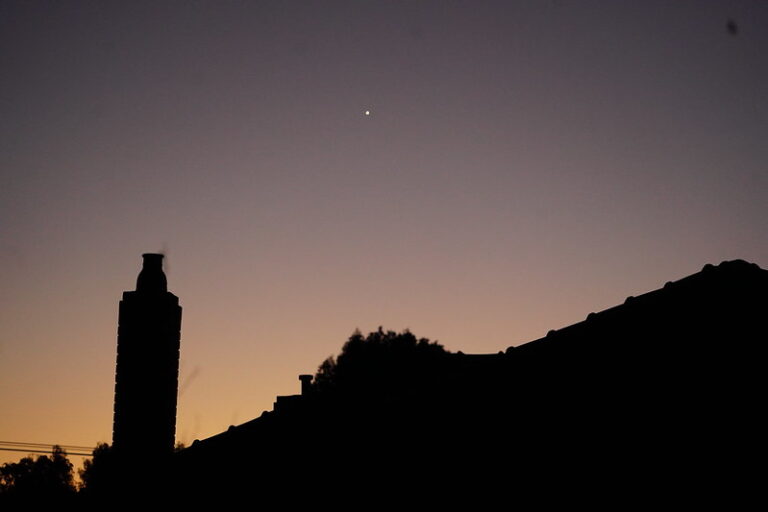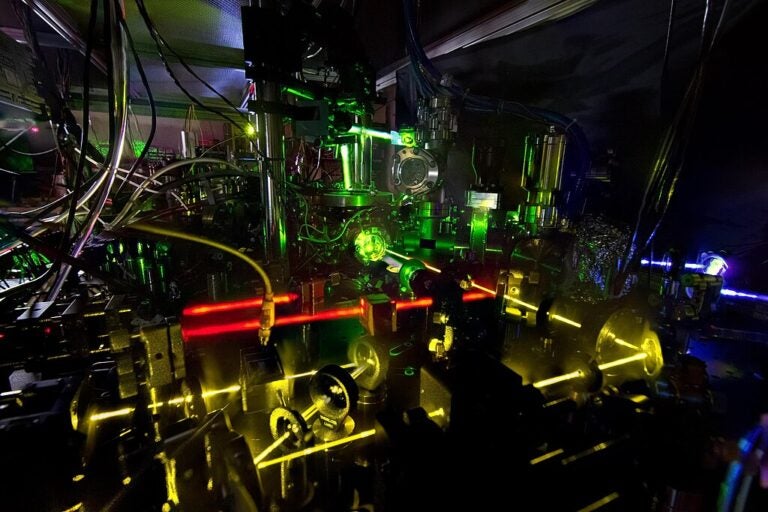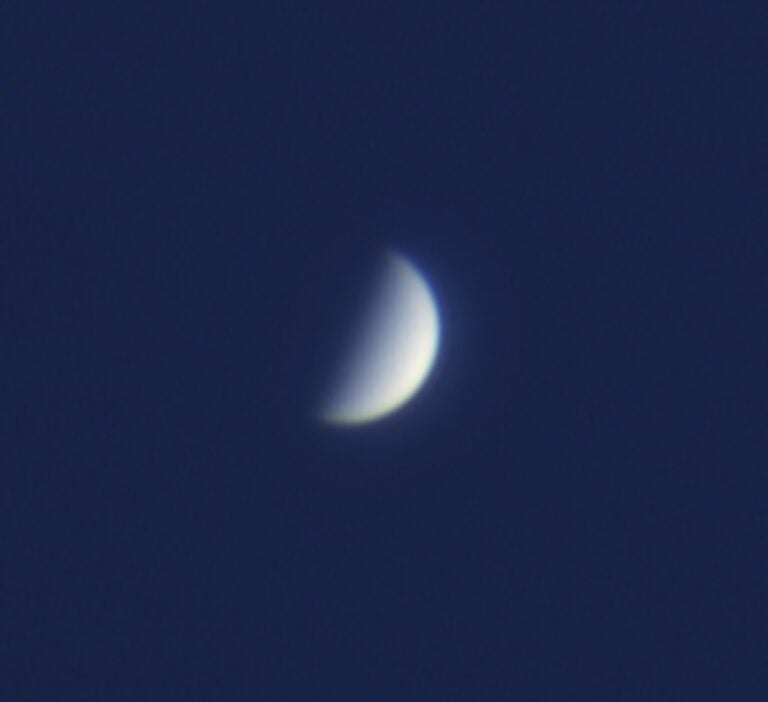Friday, November 18
The solar system’s second-to-last planet, Uranus, passes close to a star in southern Aries the Ram tonight. At magnitude 5.7, the distant world is easy to pick up with binoculars in the dark evening sky. By 8:30 P.M. local time, it’s already 50° high and a mere 1′ north of a 7th-magnitude field star, HD 18144. If you don’t have a go-to scope, first find magnitude 5.3 Pi (π) Arietis, then drop down about 1.8° toward the horizon (southeast) to find Uranus. With a telescope, the planet’s 4″-wide disk should look like a “flat” star colored pale grayish-blue.
Tomorrow night, Uranus will still sit close to the same star, about 1.5′ to its west. The planet will continue westward from here, ending the month nearly 0.5° west of HD 18144.
Sunrise: 6:49 A.M.
Sunset: 4:41 P.M.
Moonrise: 12:50 A.M.
Moonset: 2:09 P.M.
Moon Phase: Waning crescent (29%)
*Times for sunrise, sunset, moonrise, and moonset are given in local time from 40° N 90° W. The Moon’s illumination is given at 12 P.M. local time from the same location.
Saturday, November 19
Orion the Hunter is one of the dominant constellations in the autumn and winter sky. His bow is starting to clear the horizon around 6:30 P.M. local time tonight and within two hours, his entire body is visible.
The constellation’s famous belt asterism contains three stars: From east to west, they are Alnitak, Alnilam, and Mintaka. To the southeast of Alnitak is Orion’s Sword, which is actually the diffuse glow of the Orion Nebula (M42), the closest star-forming region to Earth. Rich in the gas and dust that produces new suns, this great nebula is lit up from the inside by the Trapezium Cluster, which small (3-inch) telescopes will show contains four stars between magnitude 5.1 and 7.5. The brightest is Theta1 (θ1) Orionis C (the others are named, aptly, Theta1 Orionis A, B, and D). If you bump your aperture up to 6 inches or so, you’ll see two additional stars of magnitude 11: Theta1 E (near A) and F (near C).
Look at the nebula around these stars and you’ll likely notice something: There’s less of a glow in their immediate vicinity. That’s because these young, hot suns are blasting the material around them with highly energetic UV light and particle winds, pushing it away and carving out a cavity within the larger nebula.
Sunrise: 6:50 A.M.
Sunset: 4:41 P.M.
Moonrise: 1:54 A.M.
Moonset: 2:31 P.M.
Moon Phase: Waning crescent (20%)
Sunday, November 20
With the Moon gone from the evening sky, the time is right to follow Comet C/2022 E3 (ZTF) as it heads northeast through Serpens Caput. Located near 5th-magnitude Delta (δ) Coronae Borealis, ZTF is glowing at about 10th magnitude after sunset. Once you’ve found Delta, look just 1.6° due south of the star and you’ll land right on ZTF. The region sets around 7 P.M. local time, so begin observing as soon as the sky starts to grow dark — one benefit of early sunsets this time of year.
You’ll need a 6-inch scope or better, but magnifications of 100x should start to bring out some structure within the comet. It is now about 1.4 astronomical units (AU) from the Sun, where 1 AU is the average Earth-Sun distance. The comet’s southern flank should look well defined, with a short, stubby fan of a tail along the comet’s northern edge. The coma will likely appear whitish, though there may be hints of green as the comet’s decreasing distance from the Sun triggers a glow from diatomic carbon.
You can enjoy ZTF in the same region of the sky for the rest of the month. Soon after, however, it will begin covering more of the sky each night, until it seems to almost fly across the heavens early next year.
Sunrise: 6:51 A.M.
Sunset: 4:40 P.M.
Moonrise: 2:59 A.M.
Moonset: 2:54 P.M.
Moon Phase: Waning crescent (13%)
Monday, November 21
Asteroid 324 Bamberga reaches opposition this afternoon at 1 P.M. EST. The large main-belt world is now in Perseus the Hero, who sits high in the east by 9 P.M. local time.
Bamberga is about 2.5° east-northeast of 2nd-magnitude Algol tonight. The asteroid is roughly 9th magnitude, easy to pick up with any small scope. Less than 8° north of its position is a rich grouping of stars near Perseus’ alpha luminary, magnitude 1.8 Mirfak.
Algol itself is an interesting target. It is an eclipsing binary system, whose two components pass in front of each other from our viewpoint of the system here on Earth. When uneclipsed, Algol appears about as bright as Mirfak to its northeast; however, if it’s in eclipse, Algol is much fainter. Eclipses happen every 2.867 days, meaning it’s easy to come back to this star night after night and watch it fade and then brighten again.
Sunrise: 6:52 A.M.
Sunset: 4:39 P.M.
Moonrise: 4:06 A.M.
Moonset: 3:19 P.M.
Moon Phase: Waning crescent (6%)
Tuesday, November 22
Mars is looming large in our sky as November closes, nearing its closest approach to Earth as well as an early December opposition. The Red Planet is visible all night, from soon after dark all the way until dawn, sitting near the horns of Taurus the Bull. It now glows at magnitude –1.7 and will gain another 0.1 magnitude by the end of the month.
Stretching 17″ across through a telescope, Mars is ripe for imaging. Those experienced with video capture may glean surface details; around local midnight in the Midwest, the vast scar of Valles Marineris and the dark blotch of Sinus Meridiani are facing Earth. Plus, both of Mars’ poles are on view, so compare and contrast the ice caps while you can.
Even if you’re observing with the naked eye, Mars is still a fine sight. Glance to its southwest in the sky and you’ll find a similarly colored ruddy star: That’s Aldebaran, the eye of Taurus. Once Orion rises a few hours after dusk, bright Betelgeuse joins the scene, creating a trio of red-colored lights in the sky.
Sunrise: 6:53 A.M.
Sunset: 4:39 P.M.
Moonrise: 5:18 A.M.
Moonset: 3:48 P.M.
Moon Phase: Waning crescent (2%)
Wednesday, November 23
New Moon occurs at 5:57 P.M. EST, giving us dark skies for the entire night.
The Andromeda Galaxy (M31) is a showpiece of the night sky. At this time of year, it is already high in the east by midevening and, on cold, clear nights, can be visible to the naked eye if your observing site is free of light pollution. It is one of the most distant objects you can see with the naked eye, rivaled only by the Triangulum Galaxy (M33), which only the sharpest eyes can pick up from the darkest sites.
You can find Andromeda just under 1.5° west of magnitude 4.5 Nu (ν) Andromedae. The large spiral galaxy stretches some 3° on the sky, or the width of three Full Moons! However, you may not quite see it to this extent, simply because its outskirts are dimmer than its central regions (the bulge). With a telescope, it will largely look like a dim, fuzzy, white-gray patch of light that is brighter in the center. With a 4-inch scope or larger, you’ll start to notice differences in the way the galaxy’s light fades as you look farther from the center, thanks to its orientation as well as a dark dust lane blocking some of its starlight.
Andromeda is the closest large spiral to our own and the largest galaxy in our Local Group. It is also headed for a collision with the Milky Way in several billion years — though fortunately, very few stars will actually collide as the two galaxies merge into one larger structure astronomers call Milkomeda.
Sunrise: 6:54 A.M.
Sunset: 4:38 P.M.
Moonrise: 6:33 A.M.
Moonset: 4:23 P.M.
Moon Phase: New
Thursday, November 24
The mighty planet Jupiter is stationary today at 8 A.M. EST. Located in southern Pisces, the gas giant has been moving retrograde against the background stars; after today, it will begin moving east once more. You can find the magnitude –2.6 world in the southeast as soon as it gets dark after sunset, hanging below Pisces’ Circlet asterism.
This is one planet you’ll want to study with a scope. Early in the evening, you might catch Io transiting across the gas giant’s face, starting around 6:30 P.M. EST (in darkness for those on the East Coast and twilight for those in the Midwest). By about 7:50 P.M. EST, the moon’s shadow joins it, reaching about midway across the disk as Io leaves the limb just before 8:50 P.M. EST. The shadow finally slips away around 10 P.M. EST.
Meanwhile, Jupiter’s colored cloud bands are gorgeous to observe, as its disk spans some 44″ on the sky. Look also for its Great Red Spot, which should appear by 11 P.M. EST, carried quickly across the face of the planet by the world’s rapid rotation rate.
Asteroid 2 Pallas is also stationary at 8 A.M. EST. It’s located near the tail of Canis Major, the larger of Orion’s two hunting dogs. We’ll visit it tomorrow morning when the constellation is highest.
Sunrise: 6:55 A.M.
Sunset: 4:38 P.M.
Moonrise: 7:51 A.M.
Moonset: 5:08 P.M.
Moon Phase: Waxing crescent (1%)
Friday, November 25
Although Canis Major rises before midnight, it needs some time to climb out of the turbulent air near the horizon. In the several hours before sunrise, you’ll find this loyal canine southeast of Orion and skimming above the southern horizon. Pallas, which glows at 8th magnitude, is just 2.5° southeast of magnitude 1.8 Delta Canis Majoris, also called Wezen. You can catch the main-belt world with binoculars or a small scope.
The second asteroid ever discovered, Pallas is the third-largest body in the main belt and takes just over four and a half years to orbit the Sun. Over the next month, Pallas will continue moving away from Canis Major’s tail, making a slow arc toward his back legs and ending December near Kappa (κ) Canis Majoris.
The Moon reaches perigee, the closest point in its orbit around Earth, at 8:31 P.M. EST. It will then sit 225,450 miles (362,827 kilometers) away.
Sunrise: 6:56 A.M.
Sunset: 4:37 P.M.
Moonrise: 9:07 A.M.
Moonset: 6:04 P.M.
Moon Phase: Waxing crescent (5%)

